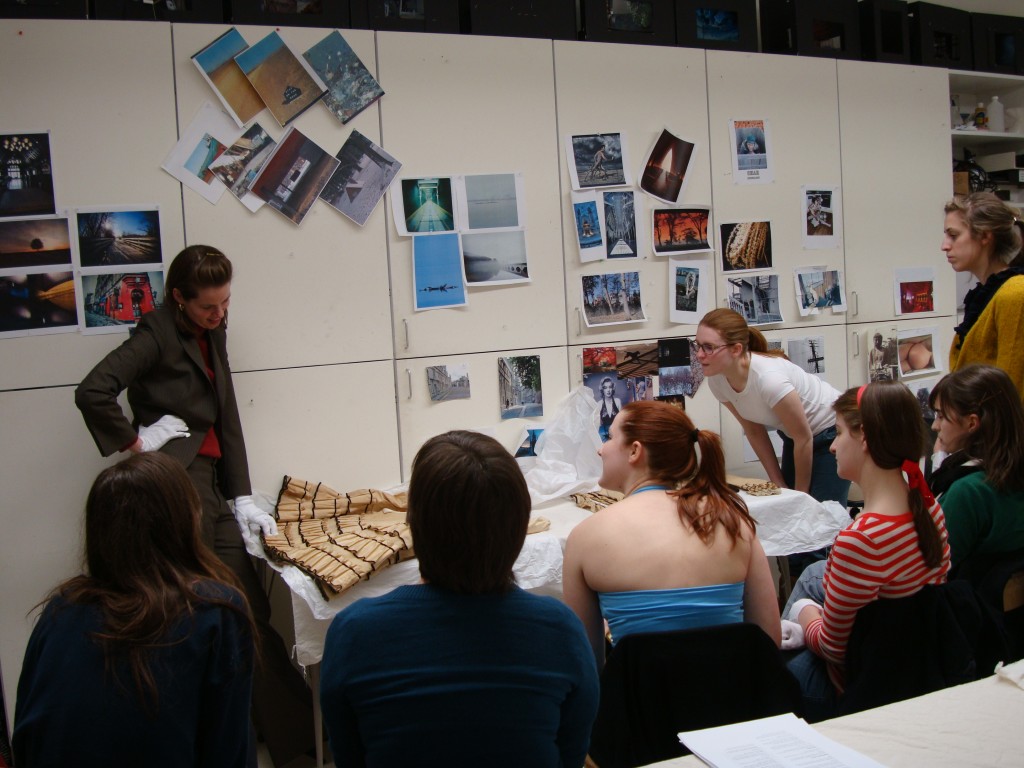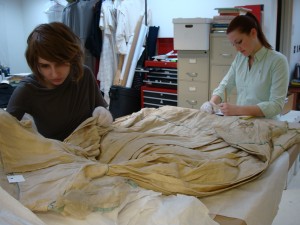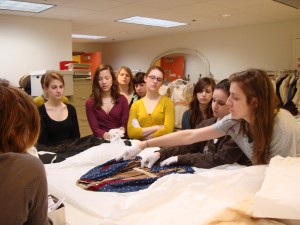February 2010
Monthly Archive
February 18, 2010
It’s hard to believe, but our second workshop has already come and gone! On Friday, February 12th, we welcomed Jessa Krick to lead our workshop about cataloging of historic costume. Ms. Krick currently works with Historic Hudson Valley, and was formerly a Senior Research Assistant for the Costume Documentation Project for the Brooklyn Museum.

After a brief round of introductions, Ms. Krick shared her presentation entitled “Object Cataloging: Idea and Practice.” She provided some background about the Brooklyn Museum Costume Collection, and then described the process undertaken for the Costume Documentation Project. Her presentation included many images of objects selected as highlights of the project, and photographed and documented for ArtStor. She provided several very helpful examples of catalog entries for objects in the Brooklyn collection, to help guide our process.
Next we took a brief cookie break, and then returned for some hands-on work with object cataloging. Ms. Krick worked with a two-piece dress from our collection to develop a catalog entry, getting students involved along the way, both in terms of remembering the best practice she had indicated in her presentation, and examining the object in detail. The piece chosen was found to have been significantly re-styled for use as a theatrical costume before it was removed from the theatrical stock and placed in the historic collection. While this aspect was frustrating at times, this made it an excellent subject for thorough investigation.
In the days since Ms. Krick’s visit, we have already implemented some changes in our procedure, as inspired by her presentation. We have started cataloging the more recent objects in our collection, and plan to work backwards in time, as Ms. Krick explained they had done with the Brooklyn project. This is a very helpful approach, allowing all of us to take some time to perfect our cataloging technique with more familiar objects before moving on to the many complicated late nineteenth and early twentieth century pieces we have in the collection.
We all learned a great deal from Ms. Krick, and we’re very appreciative for the time she spent with us.
Now we have several weeks of cataloging and condition reporting ahead. Please “stay tuned” to see what objects we unearth in the coming weeks!
February 10, 2010
On Wednesday, February 3rd, we were very lucky to have textile consultants Jonathan Scheer and Rebecca Chartier (of J. Scheer and Co., Rhinebeck and New York) present our first “formal” workshop. First, we met around the big table in the Design Room to introduce ourselves, and then Mr. Scheer spoke about the care of textiles. His talk included an introduction to the factors of textile deterioration, characteristics of fibers, best practice for handling historic textiles, and strategic planning for the care of collections.

His assistant, Rebecca Chartier, also added a great deal to the discussion, particularly concerning environmental issues affecting collections, and how to mitigate some such problems. She also shared a sample condition report and treatment/mounting plan for an object she had worked with at the National Museum of the American Indian (Smithsonian).
Then, after a short break, we moved downstairs to work hands-on with objects from our collection. Participants were divided into seven pairs, and each pair was assigned an object with a particular condition issue. Each pair worked on filling out a condition report worksheet, with close examination of the object. Mr. Scheer and Ms. Chartier circulated around the room to see what the students were discovering, offer guidance for their descriptions, and help with analysis and terminology.

Finally, we brought the group all together again, to talk about how some of the objects on display represented specific condition issues and terms. Mr. Scheer and Ms. Chartier both provided thoughtful answers to student questions, including interesting anecdotes from their personal experiences working with a variety of textiles at a variety of institutions.
The time went by far too quickly, but we are very grateful to Mr. Scheer and Ms. Chartier for this informative presentation!
February 2, 2010
Posted by Arden Kirkland under
labs | Tags:
inventory,
labs |
No Comments
Before our first workshop, we decided it was important to do a quick inventory and catch up on exactly what objects were in what boxes or drawers. We also took this as an opportunity to sort through some of the collection, taking boxes that had somewhat random contents and moving some objects to different boxes to have similar objects together.
With only a few tables to spread out on, this proved to be a daunting task. We sorted objects into different piles, but quickly ran out of space for more categories, and tried to put as many objects away as possible to make more room for new sorting piles.
Object locations were entered into the database, and we worked on making an “index” for each box or drawer – a metal ring with an index card for each object. Each index card has a photograph and a brief description. This gives a quick visual reference of what is in a given box or drawer.
Our initial goal was one box/drawer an hour, but this was unrealistic for many of the larger boxes. It was hard for some of us to move quickly through a box once we had unearthed some particularly interesting objects and got caught up looking at the details. Although “a box an hour” became our mantra, we still didn’t manage to get through all the boxes in one week. That means that our inventory process will be continued now with our more thorough cataloging process, and we’ll just have to sort out similar objects as we go.
This sorting will be on going throughout the semester. As we work more with the collection, hopefully the most logical system for organizing the collection will become apparent. Should objects be stored by period? By occasion? By fiber type? By object type? Once we have better information in the database about exactly what we have, we’ll be in a better position to decide on our ultimate sorting system.


